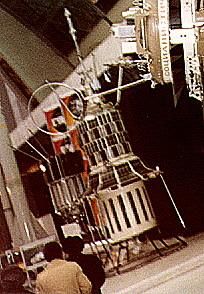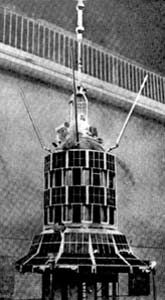
Home - Search - Browse - Alphabetic Index: 0- 1- 2- 3- 4- 5- 6- 7- 8- 9
A- B- C- D- E- F- G- H- I- J- K- L- M- N- O- P- Q- R- S- T- U- V- W- X- Y- Z
Elektron-B
 Elektron-B Credit: © Mark Wade |
Status: Operational 1964. First Launch: 1964-01-30. Last Launch: 1964-07-10. Number: 2 . Gross mass: 444 kg (978 lb).
The two spacecraft were designed to be deployed in a single launch of a Vostok booster. The spacecraft had the specific task of mapping the Van Allen radiation belts at higher inclinations than that achieved by US satellites of the time (60 degrees vs 30 degrees latitude).
Decrees authorizing design and building of the Elektrons were issued on 9 May 1960 and 13 May 1961. Design work began in July 1960. Elektron B, with a design mass of 460 kg, was boosted into a high 450 x 60,000 km orbit to map the outer Van Allen belt, simultaneous with Elektron A's study of the inner radiation belt. To attain this orbit it used a perigee kick motor - a solid rocket of 3350 kgf and 12 to 15 seconds duration. Elektron B was 400 mm in diameter and 850 mm long. The spacecraft also measured cosmic rays and the upper atmosphere.
More at: Elektron-B.
Family: Earth, High earth orbit, Magnetosphere sat. Country: Russia. Launch Vehicles: R-7, Vostok 8K72K. Projects: Elektron. Launch Sites: Baikonur, Baikonur LC1. Agency: Korolev bureau. Bibliography: 175, 2, 21, 474, 6.
 | Elektron 1 Credit: Manufacturer Image |
 | Elektron 2 Credit: Manufacturer Image |
1960 May 9 - .
- Elektron satellite approved. - .
Nation: Russia.
Spacecraft: Elektron-A,
Elektron-B.
Central Committee of the Communist Party and Council of Soviet Ministers Decree 'On approval of work on the Elektron scientific satellite' was issued. The two spacecraft were designed to be deployed in a single launch of a Vostok booster. The spacecraft had the specific task of mapping the Van Alen radiation belts at higher inclinations than that achieved by US satellites of the time (60 degrees vs 30 degrees latitude). Design work began in July 1960.
1961 May 13 - . Launch Vehicle: N1.
- Soviet response to Apollo program - .
Nation: Russia.
Related Persons: Chelomei.
Spacecraft: Elektron-A,
Elektron-B,
Kosmoplan,
LK-1,
Raketoplan.
Soviet Decree 'On the Revision of Plans for Space Objects for Accomplishing Goals of Defence Designations--heavy boosters, course of work on Elektron, and suspension of work of work on the Kosmoplan and Raketoplan with continuation of new Raketoplan work' was issued. The decree set the end of 1965 as the date for the first launch of the N1. It also authorised Chelomei to stop work on Kosmoplan interplanetary probes and instead concentrate on a specific Raketoplan design - the LK-1 manned lunar flyby spacecraft.
1964 January 30 - . 09:45 GMT - . Launch Site: Baikonur. Launch Complex: Baikonur LC1. LV Family: R-7. Launch Vehicle: Vostok 8K72K.
- Elektron 2 - .
Payload: 2D s/n 2. Mass: 444 kg (978 lb). Nation: Russia.
Agency: Korolev bureau.
Program: Elektron.
Class: Earth.
Type: Magnetosphere satellite. Spacecraft: Elektron-B.
Decay Date: 1997-04-22 . USAF Sat Cat: 748 . COSPAR: 1964-006B. Apogee: 62,811 km (39,028 mi). Perigee: 5,611 km (3,486 mi). Inclination: 60.20 deg. Period: 1,356.40 min.
Studied outer Van Allen belt. Electron I and II launched by a single carrier rocket. Electron I: simultaneous study of the Earth's inner and outer radiation belts, cosmic rays and upper atmosphere. Electron II: simultaneous study of the Earth's inner and outer radiation belts, cosmic rays and outer space.
1964 July 10 - . 21:51 GMT - . Launch Site: Baikonur. Launch Complex: Baikonur LC1. LV Family: R-7. Launch Vehicle: Vostok 8K72K.
- Elektron 4 - . Payload: 2D s/n 4. Mass: 444 kg (978 lb). Nation: Russia. Agency: Korolev bureau. Program: Elektron. Class: Earth. Type: Magnetosphere satellite. Spacecraft: Elektron-B. Decay Date: 1983-10-12 . USAF Sat Cat: 830 . COSPAR: 1964-038B. Apogee: 66,269 km (41,177 mi). Perigee: 447 km (277 mi). Inclination: 60.80 deg. Period: 1,313.80 min. Studied outer Van Allen belt. Electron 3 and 4 launched by a single carrier rocket. Simultaneous study of the inner and outer radiation belts of the earth, cosmic rays and the upper atmosphere. .
Back to top of page
Home - Search - Browse - Alphabetic Index: 0- 1- 2- 3- 4- 5- 6- 7- 8- 9
A- B- C- D- E- F- G- H- I- J- K- L- M- N- O- P- Q- R- S- T- U- V- W- X- Y- Z
© 1997-2019 Mark Wade - Contact
© / Conditions for Use